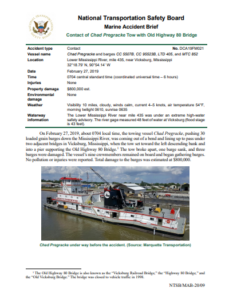The NTSB issued an investigation report on the contact of the towing vessel ‘Chad Pregracke’ with Old Highway 80 Bridge on the Lower Mississippi River, in February 2019. The report indicated the pilot’s misjudgment of the river current as key cause of the incident.
The incident
On 27 February 2019, about 0704 local time, the towing vessel Chad Pregracke, pushing 30 loaded grain barges down the Mississippi River, was coming out of a bend and lining up to pass under two adjacent bridges in Vicksburg, Mississippi, when the tow set toward the left descending bank and into a pier supporting the Old Highway 80 Bridge.
The tow broke apart, one barge sank, and three barges were damaged. The vessel’s nine crew members remained on board and began gathering barges.
No pollution or injuries were reported. Total damage to the barges was estimated at $800,000.
Probable cause
The National Transportation Safety Board determines that the probable cause of the contact of the downbound Chad Pregracke tow with pier 3 of the Old Highway 80 Bridge was the pilot’s misjudgment of the effects of the river current acting on the tow while navigating the bend before the bridge at Vicksburg in high-water conditions.
Analysis
The history of bridge strikes at the Old Highway 80 Bridge indicates that the location of the bridge and the geography of the approach make it difficult for downbound tows to pass under the span, particularly in high water.
In addition, high water on the day of the accident produced fast currents that increased the risk of contact while navigating a tow under the bridge.
The pilot was aware of the increased risk of striking the Old Highway 80 Bridge due to the high water and acknowledged that he felt comfortable transiting the area with the tow.
The pilot also believed that the Chad Pregracke was capable of steering the 30 barges through the bend before the bridge span, since he had successfully navigated the bend at Brown’s Point, and he had previous experience transiting the Old Highway 80 Bridge during extreme high water.
In an attempt to steer the bend at Vicksburg, the pilot maneuvered the long, 1,173-foot tow using the Chad Pregracke’s engines and rudders to create a force to swing the bow to starboard and align the tow to pass through the 800-foot wide span.
With the pivot point closer to the aft end of the tow (about one-third of the tow’s length from towboat’s stern), the force acting on this smaller lever to steer the tow was not enough to overcome the force of the cross-currents acting on the larger lever of the tow (the remaining two-thirds of the tow’s length), and the current turned the head of the tow and pushed it to port.
Although the tow configuration and the pilot’s high-water experience met the Coast Guard’s recommended guidelines for mitigating the risk of a bridge strike, the pilot could not overcome the effect of the current on the tow.
Explore more herebelow:

See also:






























































